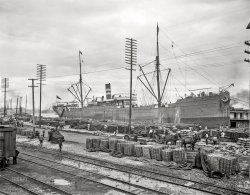
MAY CONTAIN NUTS

Search Shorpy
SHORPY ART

Framed or unframed, desk size to sofa size, printed by us in Arizona and Alabama since 2007. Explore now.
Join and Share
Ad-Free Shorpy
Shorpy is funded by you. Patreon contributors get an ad-free experience.
Learn more.

Recent comments
- Tobacco cam
- Basic fact I learned only later in life
- Put a Lid on it!
- Pinstripes in the Tower
- Sound enhancement
- 3438 in '38
- Second Career
- Their days are numbered
- Only the Sensor
- Train control mechanism
- Rarest of the Rare?? & Classy 3400 Class
- Control Mechanism
- Those standpipes
- Wrenches
- International D-40 I believe
- Job prospects
- You had me at Train
- Land of the free
- Broad-Exchange Bldg
- Parking innovation
- The old block
- "Peck turned a sweet propeller"
- National Bank Building
- Notch shot
- Straight ahead (right, left, left, right)
- Ship lifespans
- New service
- You Say Station, I Say Potato ...
- Iron Age
- Thank you, Cornelius Vanderbilt
Member Photos
The Shorpy
Printporium
Printporium
Search Shorpy
Search results -- 30 results per page
- French Quarter: 1956
- Kodachrome taken by my dad in New Orleans in February 1956. View full size.
Royal St and St Ann ... your picture, thanks!!!
(ShorpyBlog, Member Gallery, New Orleans) ... Posted by rsyung - 05/09/2014 - 10:54pm -
![French Quarter: 1956 Kodachrome taken by my dad in New Orleans in February 1956. View full size.
Royal St and St AnnLooking into the window of what is now a restaurant.
View Larger Map
Regal BeerCheap party beer in the late 60's early 70's. A case could be had for around $10.
Left to Right'55 Chrysler, '49 Chevy, '53 or '54 Chevy, '48-'49 Cadillac, '53 Buick Super, '56 Buick Special, '53-'54 Chevy.
Print of this photoHi - I would like to purchase a print of this photo. How can I do that? Thanks!
[You can send a message to the member who submitted this photo by clicking on their name ("rysung") above the photo and then the Contact tab on their profile page. -tterrace]
French Quarter: 1956 PictureHi @rsyung- I am looking for a copy of this picture, but your profile info is private. Can you please let me know how I can get a copy of your picture, thanks!!!
(ShorpyBlog, Member Gallery, New Orleans)](https://www.shorpy.com/files/images/VieuxCarre56.thumbnail.jpg)
- Hanging Out: 1937
- New Orleans circa 1937. "1133-1135 Chartres Street." Laundry day in the ... hospitality 1133 Chartres (pronounced "charters" in New Orleans) St. is now the Soniat House hotel.
Say "Cheesy" ... wasn't shot on location).
(The Gallery, F.B. Johnston, New Orleans) ... Posted by Dave - 07/19/2012 - 4:36pm -
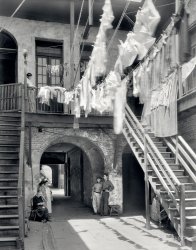
- Glad-U-Kum: 1910
- April 1910. "Scottish Rite Cathedral, New Orleans." 8x10 inch dry plate glass negative, Detroit Publishing Company. ... this was located in the famous Red Light district of New Orleans, Storyville.
Red Light District Not quite. It's in the ... the Scottish Rite Temple in 1906.
(The Gallery, DPC, New Orleans) ... Posted by Dave - 08/14/2012 - 3:41pm -
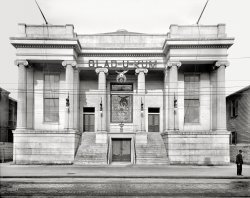
- Liberty Street: 1937
- New Orleans, Louisiana, circa 1937. "Liberty Street cottages." 8x10 inch ... blighted ones too.
(The Gallery, F.B. Johnston, Kids, New Orleans) ... Posted by Dave - 08/14/2012 - 3:53pm -
![Liberty Street: 1937 New Orleans, Louisiana, circa 1937. "Liberty Street cottages." 8x10 inch acetate negative by Frances Benjamin Johnston. View full size.
Under the bridgeIf 1010 Liberty still exists, it would just about be under the Pontchartrain Expressway.
Shoe renewalNewly white, drying in the sun.
Step to Rocking ChairEvery time I see small children in these photographs, it make me wish I could have had a nice long talk with the elderly person that child turned out to be. My grandfather died 27 years ago and was born about the time this kid was.
What's in a name?When I close my eyes and envision a "cottage", this ain't it. I do like the wrought iron fence detail to the left, though.
That's a healthy home!Having plenty of "Three Sixes," they never had to worry about colds or malaria.
Ad nauseam: 666All you'd ever want to know about the 666 brand, here, here, here and here. (Scroll down to the comments.)
Empty Shoes #5This may be really silly but I have been keeping track of the Johnston photos with orphan shoes. So far:
1. https://www.shorpy.com/node/8628?size=_original
2. https://www.shorpy.com/node/8615?size=_original
3. https://www.shorpy.com/node/8586?size=_original
4. https://www.shorpy.com/node/8559?size=_original (?)
5. https://www.shorpy.com/node/8783?size=_original
Aye, 'tis a tough job, but somebody has to do it.
He is only 73 years oldThis lonely little fellow could very well still be among us and wouldn't it be amazing if he could reveal himself? After the detective work done by all the viewers of tterrace's advertising photo (which ended up solving ALL the mysteries therein), I'm convinced that the intelligentsia of Shorpy fans can research and find out anything they put their minds to. This is a great photo, very inspirational potential for writing a little story. Thank you Shorpy for giving me a hobby.
[Math check: More like 75. - Dave]
Treme StreetThis was on North Liberty, which was renamed Treme Street. This corner is now vacant, and I think this Creole cottage is gone too. The building with the dormer was a church, now in horrible condition. I think it is due for renovation though. The house right next to it is very nice, and there are many great buildings nearby. Too many blighted ones too.
(The Gallery, F.B. Johnston, Kids, New Orleans)](https://www.shorpy.com/files/images/01297u.thumbnail.jpg)
- Nite Club: 1938
- ... by the Jackson Brewing Company near Jackson Square in New Orleans. The bottles each had a joke or riddle printed under the cap. The ... Posted by Dave - 06/04/2008 - 8:59am -
![Nite Club: 1938 October 1938. "Porch of small Negro store near Jeanerette, Louisiana." 35mm negative by Russell Lee for the Farm Security Administration. View full size.
Strong MedicineThe triple 6 brand has been around a long time, manufactured Florida's own Monticello Drug Company, now a division of Lee Pharmaceuticals.
http://deuceofclubs.com/write/666.htm
Two asides: Jax was a beer made in Louisiana The store behind them was Colored Only?
[The sign says NITE CLUB Colored Only - Dave]
Jax JokesJax beer was brewed by the Jackson Brewing Company near Jackson Square in New Orleans. The bottles each had a joke or riddle printed under the cap. The jokes weren't very funny - sort of like the Palooka Joe comics on bubblegum wrappers back in the day.
Goober Pea
666My eye was drawn too to the 666. I spent a few hours just recently online finding out what this sign meant. Flannery O'Connor mentions a motorist seeing it on a Southern highway in "Wise Blood." And so it is by coincidence that I find out what she was referring to.
Six Sixty SixThanks for the link to deuceofclubs and the info on 666 products. I had no idea such a thing existed.
The site mentioned that 666 items can be found out west, but what about other parts of the country? If 666 cough medicine were on sale in the bigger college towns here on the East Coast, Monticello Drugs would be as big as Dr. Bronner's within three years.
JaxWell, since we're on the subject, who else remembers the Jax Beer commercials done by Mike Nichols and Elaine May?
"Jax! The beal jeer!"
“Bartender, are you making fun of me?”
I suppose it's fitting that some of our most vividly imprinted memories are of the commercials of our youth.
Little GirlNote the little girl on the far right. SO adorable!
Jax Beer CommercialsI loved them and wish I could get a copy. On our 4,548 mile road trip my 6-year-old grandson bought a beer in Idaho and named him Jaxie. Well that brought it up and I went through about five of them. At the end of the trip he was saying "rrr..rrr...rrr...Coolidge?"
[Eh? Six years old? "Coolidge"?? Below: Commercials. - Dave]
Goldcrest BeerThe box on top of the Jax is Goldcrest Beer, made by the Tennessee Brewery in Memphis. Went out of business in 1954.
(The Gallery, Eateries & Bars, Russell Lee, Stores & Markets)](https://www.shorpy.com/files/images/8a24608u_0.thumbnail.jpg)
- Lane Mill: 1913
- November 1913. New Orleans, Louisiana. "Group of workers in Lane Cotton Mill showing the youngest workers and typical of conditions in New Orleans. Violations of the law are rare." Photo by Lewis Wickes Hine. ... in our family.
Lane Cotton Mill I found a local (New Orleans) history column about the Mill. It lasted almost 100 years. Not ... Posted by Dave - 11/13/2012 - 3:43pm -
![Lane Mill: 1913 November 1913. New Orleans, Louisiana. "Group of workers in Lane Cotton Mill showing the youngest workers and typical of conditions in New Orleans. Violations of the law are rare." Photo by Lewis Wickes Hine. View full size.
American HistoryAgain, those young people look like they're having a good time. Those 1913 children and teenagers seem content with their lot. Very few of their peers probably objected. Just about nobody in their "crowd" went to or graduated from high school anyway. If one's parents hadn't finished high school it was a good bet they wouldn't either. Let's us give Lewis Hine his due, he did publicize their plight. Again, I remember historian Doris Kearns Goodwin's book "No Ordinary Times," in which she wrote that less than 25 percent of WWII draftees had finished high school. When that war ended, the US Congress, in order to keep the multi-millions of servicemen out of the labor market, passed a bill then referred to as the "GI Bill of Rights." Instead of becoming a stalling mechanism it became the great equalizer. It allowed millions of returning GIs to finish high school or go to college. This created a middle class that became the envy of the world.
[The point Hine is making in this caption is that none of these kids was underage. - Dave]
I understand that. My point is that these young people didn't have a shot at continuing their education. Those few dollars that they earned were needed at home.
How young could you be?If none of these kids were underage, what was the minimum age at that time for mill work? Those boys in front seem 11-14 years old, tops.
And like most kids everywhere, they do seem to be enjoying the photo op.
[14 was the minimum age for mill work in Louisiana and several other states as of 1912. See this contemporary report. - tterrace]
14, and aging fastAround 1900, my step great grandfather was a subject in his mothers divorce. the decree stated that she would be responsible for his care until he reached the age of 14. A month after his birthday, his step father ordered him from the farm, as he was deemed "to light-weight to do farm work". Eventually he joined our family and provided shelter and sometimes food to many in our family.
Lane Cotton MillI found a local (New Orleans) history column about the Mill. It lasted almost 100 years. Not bad.
LaborLike just about everything else you could do, working in a cotton mill looks a lot more pleasant than working in a coal mine (goin' down, down, down...) They all look relatively happy and neatly dressed compared to some of the child labor seen here.
(The Gallery, Kids, Lewis Hine, New Orleans)](https://www.shorpy.com/files/images/SHORPY_02876u.thumbnail.jpg)
- Proteus: 1903
- March 23, 1903. "S.S. Proteus . High water at New Orleans levee." 8x10 inch dry plate glass negative, Detroit Publishing ... I've encountered.
(The Gallery, Boats & Bridges, DPC, New Orleans) ... Posted by Dave - 07/19/2012 - 4:40pm -
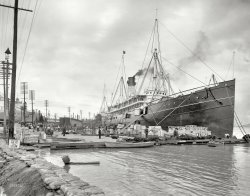
- Raft Warehouse: 1943
- March 1943. "New Orleans, Louisiana. Loading a rubber raft onto a truck at the terminal of ... the war, especially as used on the Higgins built there in New Orleans.
Canvas float I believe that is a Carley float --a kapok or ... a lot less comfortable over time.
War Production New Orleans was a major center of war production in WWII including Higgins ... Posted by Dave - 03/20/2019 - 11:38am -
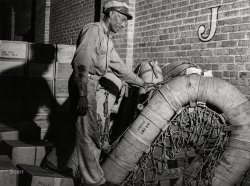
- Angola Prison Farm: 1910
- ... can be seen at his grave memorial in Metairie Cemetery in New Orleans. The captain of the steamer on this day is my great grandfather Sam ... Posted by Dave - 08/08/2012 - 2:31pm -
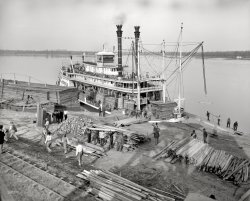
- The Sentinel: 1942
- New Orleans, July 1942. "Coast Guardsman standing watch over 78-foot torpedo ... signaling.
(The Gallery, Kodachromes, Howard Hollem, New Orleans, WW2) ... Posted by Dave - 08/30/2012 - 4:43pm -
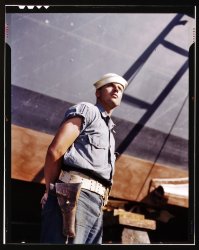
- Dufilho Pharmacy: 1936
- New Orleans circa 1936. "Dufilho Pharmacy, 512 Chartres St." Plus bills of the ...
Prescriptions filled elsewhere. It's now the New Orleans Pharmacy Museum.
View Larger Map
Surprised ... see that this building still exists! Even knowing how well New Orleans hangs onto these vintage structures, it was in such rough shape 76 ... Posted by Dave - 10/04/2012 - 1:12pm -
![Dufilho Pharmacy: 1936 New Orleans circa 1936. "Dufilho Pharmacy, 512 Chartres St." Plus bills of the hand- and -board variety. Photo by Frances Benjamin Johnston. View full size.
more on EllaThere was also a famous movie based on the strip, starring Colleen Moore.
666 Colds FeverSounds kind of ominous. Think I'll just tough it out without the medicine, thank you.
Ella Cinders!I was not familiar with Ella Cinders. It appears she was a long running syndicated comic strip. Famous enough to be hawking oil.
Federal Theatre PosterThe WPA poster on the derelict building announces a production of the WPA Federal Theatre Playhouse at 2301 Tulane Avenue. "Art and Mrs. Bottle" was first produced in London in 1929, and in New York in 1930, starring Jane Cowl and the young Katherine Hepburn. Its author, I was surprised to find, was Benn Wolfe Levy (1900-1973), a British playwright who was married to the American actress Constance Cummings, and who later served in the House of Commons from 1945 to 1950 as the Labour Party Member for Eton and Slough. The Federal Theatre project also produced his 1932 comedy "The Devil Passes."
[Poster available here. - Dave]
Prescriptions filled elsewhere.It's now the New Orleans Pharmacy Museum.
View Larger Map
SurprisedI was shocked to see that this building still exists! Even knowing how well New Orleans hangs onto these vintage structures, it was in such rough shape 76 years ago that I was sure it had been razed by now. Looks like a great restoration.
(The Gallery, F.B. Johnston, New Orleans, Stores & Markets)](https://www.shorpy.com/files/images/SHORPY_01224a.thumbnail.jpg)
- The Old Basin: 1906
- New Orleans circa 1906. "Charcoal lugger in the Old Basin." 8x10 inch dry plate ... (1861-1934) in 1891, for J.L. Mestier & Company of New Orleans.
The Mabel E. Judlin was 67 feet long, had a beam of 22 feet, ... Her sails were constructed by A. Gerdes & Brother of New Orleans. (The Biloxi Herald, May 2, 1891, p. 4, c. 2) The Mabel E. Judland ... Posted by Dave - 08/21/2012 - 10:49am -
![The Old Basin: 1906 New Orleans circa 1906. "Charcoal lugger in the Old Basin." 8x10 inch dry plate glass negative, Detroit Publishing Company. View full size.
That's MY CigarThat kid kneeling on the right looks he really wants that cigar. Either that, or he just had it taken from him.
Schr. Mabel E. Judlin
from A History of Vancleave, Mississippi,
by Ray L. Bellande.
Miss Mabel Judlin was the namesake of another trading schooner, the Mabel E. Judlin. This vessel was constructed at Handsboro by Matteo Martinolich (1861-1934) in 1891, for J.L. Mestier & Company of New Orleans.
The Mabel E. Judlin was 67 feet long, had a beam of 22 feet, and hold depth of 4 feet. Her sails were constructed by A. Gerdes & Brother of New Orleans. (The Biloxi Herald, May 2, 1891, p. 4, c. 2) The Mabel E. Judland (sic) was reputed to be the fastest schooner in the entire Gulf and Caribbean. She hauled charcoal from the banks of Bluff Creek when owned by James E. Lockard (1862-1951) of Vancleave. The fledging United Fruit Company used the Mabel E. Judland (sic) as a model for their shallow draft fruit boats. (Down South, July-August 1960, p. 9)
What Catches My EyeThe schooner Mabel E Judlin is hardly the elegant sort of craft that Canadians think of when we think of schooners. The Bluenose would turn up her nose at this example of the type.
What really catches my eye about this photo is the fellow, who can't be too far into his teens if he's even made it that far, with the sack over his back and his cigar at a jaunty angle. Looks like he could whup his weight in wildcats and not disturb the ash from that stogie.
What's in a name?I'm still not sure if the lugger referred to pertains just to the boat or to the kid with the burlap sack.
[The charcoal (and oyster) luggers are the boats. - Dave]
(The Gallery, Boats & Bridges, DPC, New Orleans)](https://www.shorpy.com/files/images/4a13313a.thumbnail.jpg)
- Crate and Barrel: 1906
- Circa 1906. "Dock conveyors, New Orleans." On the waterfront along the Mississippi. 8x10 inch glass ...
Since Morgan operated a service between Havana and New Orleans at the time this photograph was taken, I suspect the contents of ... offend Temperance.
(The Gallery, Boats & Bridges, DPC, New Orleans) ... Posted by Dave - 08/08/2012 - 2:01pm -
![Crate and Barrel: 1906 Circa 1906. "Dock conveyors, New Orleans." On the waterfront along the Mississippi. 8x10 inch glass negative, Detroit Publishing Co. View full size.
I'm just dying to knowWhat's in those crates and barrels! Any guesses?
Machine Age at the docksWas impressed to note the labor saving conveyor belt moving those hand trucks efficiently along. Comparing the motion blur of people versus belt, that thing offered very little opportunity to rest one's back.
Pretty nifty hoist assembly up above as well. Wonder how that worked? Gotta love those gears.
Those barrels do look provocative, don't they?
DetailsI noticed the conveyor also, I wonder what powers it? It appears that they are offloading the ship and the conveyor must be capable of running either direction.
The man walking parallel to the conveyor (away from ship) has something stuck in his belt. It's not a radio and too large to be the butt of a pistol?
[It's the handle of a longshoreman's hook. - Dave]
Re: I'm just dying to knowIf this were an episode of The Simpsons, all those crates and barrels would be filled to the brim with hot pants.
Fancy ApronThe hoist mentioned below, with all the pulleys, is not for handling cargo. The boom on the ship, with its base on the deck-house and its attendant lines rigged to the mast is doing that. Ships of this era were fully capable of loading and unloading themselves in even the most undeveloped port.
The hoist raises and lowers the outboard ends of two aprons fixed to the pier. Thus the aprons (ramps) could be adjusted to any deck height or tidal condition.
Only the apron with the moving belt is in use, and the power seems to be a mystery. A giant hamster-wheel out of view, perhaps. The belt does seem to be valuable enough to justify a long canvas cover to protect it from the weather when not in use.
The vessel shownhere is the New York, built of iron in 1875 at Wilmington, Delaware, by Harlan & Hollingsworth for Charles Morgan's Morgan Steamship Company. She measured 283 feet in length, powered by the typical triple-expansion steam engine of the day. She was broken up in 1923. Charles Morgan instituted the first steamship line on the American East Coast in 1834. By the time of Morgan's death in 1877, he had amassed quite a transportation empire primarily based on Southern railroads, but of which the steamship company was a prime component. His heirs sold their holdings to C. P. Huntington, who merged them into the Southern Pacific in 1888, but the steamship operation remained known as the Morgan Line until wound up in 1941.
Since Morgan operated a service between Havana and New Orleans at the time this photograph was taken, I suspect the contents of the barrels are either molasses or its potent by-product, rum.
Nifty HoistThat's called a gantry, I'm sure it is used to lift the end of the bridge the conveyor is on. This allows for the transition of heights of decks of different ships and tidal changes, too. It hinges on the dock end.
Not a walkie-talkieSign of the times. I did a double take on that hook handle, it looks so much like a walkie-talkie!
*Click* "Hey Joe, tell the boys to stay off the conveyor if they wanna keep their shoes polished. There's a nasty surprise at the far end!"
And let's hope there's nothing in those barrels that would offend Temperance.
(The Gallery, Boats & Bridges, DPC, New Orleans)](https://www.shorpy.com/files/images/4a17914a.thumbnail.jpg)
- End of the Line: 1963
- ... standard gauge, 4' 8 1/2". Philadelphia, Pittsburgh and New Orleans still run on 5' 2 1/2" track. Toronto, Canada, operates to this day ... Posted by Dave - 01/30/2013 - 9:44pm -
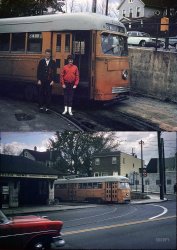
- Mrs. Foote: 1933
- ... after a series of adventures.
From Australia to New Orleans was the next leg of the voyage that was to ultimately bring her to ... Posted by Dave - 08/07/2012 - 11:03am -
![Mrs. Foote: 1933 1933. "Mrs. Walter A. Foote, portrait with dog." Harris & Ewing. View full size.
Beautiful shadows.Mrs. Foote's shadows on the wall are beautifully placed. But where's the dog's Gramophone?
StandardsSo many nasty comments about women on this blog. Too bad -- I love it otherwise.
And, yes, I am rather a homely broad myself. And if 80 years from now people are taking cheap shots at a picture of me on whatever blog equivalent is available by then ... well, actually, I will be dead and won't care. But still.
I assume...... that Mrs. Foote is the one on the right?
That DogOK, that dog had to be some movie actor dog. I think he is just way too cute and perfect. I'd steal him if I could!
Yip.The doggie is completely adorable and I happen to think Mrs. Foote is a rather handsome woman. From another homely (old) broad.
I get a weird vibe...that Mrs. Foote would have been an interesting gal to hang out with.
Hear hear!Well I'm no "homely broad" just any average Joe and I agree, the number of misogynistic comments on Shorpy is as astounding as it is dull. Makes an otherwise brilliant blog a tad tiresome. And it's not about being politically correct chaps it just shows a lack of imagination. Mrs Foote's dog looks like it has more class than some commentators.
Enjoy the show and leave the petulance on your desktop.
[If only. - Dave]
Shorpy GirlsI have made a few snarky comments about the appearance of some of the women on Shorpy. I really don't mean it as a personal insult to the (long dead) women themselves or as an insult to women in general.
For me, it's the contrast of what women looked like before the modern cosmetics industry, before daily baths became the norm and especially before dentistry evolved to its current level.
Sometimes, Shorpy makes me feel nostalgic for a simpler time. Many of the Shorpy women make me happy to be a modern man.
Oh...And Mrs Foote looks like a young Donald Sutherland in drag.
A diplomat's wife.I couldn't find anything about Mrs. Walter A Foote, but Google gives up the occasional factoid about Walter A. himself. Follow the leads through the URLs below if you'd like.
Walter A. was born in Greeneville, Texas in 1887, served in the military during WW I and was appointed to the US diplomatic corps in or about 1921. His first job was in Port Said. (He was paid $3000--per year, it looks like.) He rose through the ranks, we can assume, and was eventually appointed Consul General to Indonesia. He was there in 1947, aged 60, when these Life photos
http://images.google.com/hosted/life/l?imgurl=ffb8b49d78f10f41&q=%22Walt...
were taken. Notice his hat. Still a Texas boy.
Here are a couple of other references.
http://www.archive.org/stream/registercontaini1922unit/registercontaini1...
http://books.google.com/books?id=Nf1yXJfnakoC&pg=RA1-PA89&lpg=RA1-PA89&d...
Cheers and enjoy!
"Tiresome and Repetitive"For every comment on a woman's appearance on this site, there must be ten times as many complaining about those comments. And they all sound exactly the same. Talk about tedious.
Margaret FooteWalter Ambrose Foote's obituary (Dec 1, 1954) lists his wife's name as Margaret. She must have been an adventurous soul to travel the world with her husband. I think she looks lovely.
Below is an account of the Footes' escape from Java just in advance of the Japanese invasion:
The wife of "Uncle Billy" Foote, who as a member of our foreign service has a longer career of service in those islands than any of his compatriots, Mrs. Foote left Batavia "just before the last." Leaving from Tjilatjap
where the refugees sat up in a tin shack through a night that never seemed to end, waiting for a ship to sail, Mrs. Foote arrived in Australia after a series of adventures.
From Australia to New Orleans was the next leg of the voyage that was to ultimately bring her to a "duration" home in the Capital. during the two months of her journeying, she had no word of her husband. Like Dr. van der Plas, he wanted to stay on in the indies, but officials convinced him that he could help them more by leaving and carrying on the struggle from "outside."
After receiving word that it would be fatal to tarry and longer in Batavia, where he was Consul General, Mr. Foote got what remained of his staff together. That night they spend tearing up official papers and when morning came, and there would be no danger of it being used as a beacon light by Japanese bombers, a huge bonfire was started. Then came the trek to a port - driving along overgrown jungle roads to avoid the danger of parachutists who were clogging up the main roads. Two months later, his ship put in at San Francisco, and this was the first news either husband or wife had of each other.
Now "Uncle Billy," as he has been affectionately known by officials in the Dutch East Indies for years, is again serving overseas. He will represent this country in dealings with the Netherland's officials in Australia. His wife has been kept busy attending auction sales - where she picked up all the furniture for her attractive apartment at the Dorchester. One does not bring back household goods from an invaded territory.
English-born Mrs. Foote, who worked in New York for the Red Cross in the last war, is filling her hours with war activities. Working with the Dutch unit of the Red Cross as she is in Washington, is nothing new for the soft-spoken Mrs. Foote. For many months, she was a hard worker for numerous women's defense organizations in Batavia who had a chance to prove the effectiveness of their training under fire.
"They were magnificent," accolades Mrs. Foote, as she tells story after story of their "extraordinary calm, cool bravery."
Washington Post, Aug 2, 1942
And I'm sure......that you're just beautiful in every way yourself, Bill! Or at least as pretty as Mrs. Foote -- or, indeed, a young Donald Sutherland.
I don't think anyone is taking these comments as a "personal insult." It's just tiresome and repetitive and kind of sad, and not, perhaps, of tremendous interest to others, to know whether a given lady pleases the eye of a particular modern male. Though I can't speak for anyone but myself, naturally.
As you note, the ladies in question have usually lived out their lives -- happily and usefully, we all trust, and in times when gentlemen, whatever they thought of ladies' looks, declined to make crude remarks about them in public forums.
(The Gallery, Dogs, Harris + Ewing, Portraits)](https://www.shorpy.com/files/images/12960a.thumbnail.jpg)
- French Market: 1906
- The Crescent City circa 1906. "The French Market, New Orleans." 8x10 inch dry plate glass negative, Detroit Publishing Company. ... so for these poor horses and mules.
(The Gallery, DPC, New Orleans, Stores & Markets, Streetcars) ... Posted by Dave - 07/19/2012 - 4:36pm -
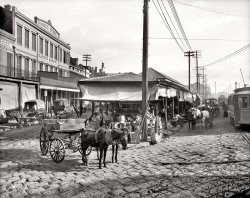
- Smart Clothes: 1910
- Canal Street in New Orleans circa 1910. Large building is the Maison Blanche department store. ... Luzianne Coffee sign on top of Williams' Pharmacy and the New Orleans Railway and Light Company station at right center. Once again, I ...
View Larger Map
(The Gallery, New Orleans, Stores & Markets, Streetcars) ... Posted by Dave - 02/06/2014 - 2:08pm -
![Smart Clothes: 1910 Canal Street in New Orleans circa 1910. Large building is the Maison Blanche department store. 8x10 inch glass negative, exposed about six minutes before this image, posted here three years ago. Detroit Publishing Co. View full size.
I had to do itLeapin' Lazard's, sorry.
Glad=U=KumI count a total of 10 streetcars in less than two blocks. However, I wondered what the Glad=U=Kum sign was supposed to signify. So I did a Google search and once again, Shorpy comes up with the answer.
Subtle differencesIt looks like this photo was taken the day after the first photo. Probably because the first photo was out of focus. Notice the awnings on the building in front of the department store are different, puddles have evaporated and the traffic officer is suddenly missing.
[The other photo is not out of focus, the puddles are the same in each picture, and the same horse is at the curb in both photos. - Dave]
WOWLots of incredibly detailed photos here on Shorpy, but this has to be one of the best. I especially like the Luzianne Coffee sign on top of Williams' Pharmacy and the New Orleans Railway and Light Company station at right center. Once again, I can almost hear some nascent jazz somewhere down the street.
Are these women doing anything?Are these women handing leaflets out? The two women standing back to back look like they are wearing sashes and they all look like they are holding papers. What do you think??
Adler's still thereAdler's jewelry store is still open at this location, although they have expanded into the building lakeward.
Adler's was founded in 1898, located at Royal and Iberville in the French Quarter. They moved to 1810 Canal street and to the present location in 1909 (putting a maximum age on the photo). The clock is a local landmark and still present, but without the pedestal - it's now supported by some steel beams from the overhang. Coleman E. Adler III currently runs the business started by his great grandfather.
Most of the other buildings in the photo also remain.
Adler's JewelersAppears to be in the same place. However, the clock in front of the store is no longer on a post. There's also a Mercedes where the horse and buggy were once parked:
View Larger Map
(The Gallery, New Orleans, Stores & Markets, Streetcars)](https://www.shorpy.com/files/images/SHORPY_4a23684a.thumbnail.jpg)
- Grocery Run: 1940
- ...
Mulatto I've met a number of persons of color from New Orleans over the years. Many are VERY proud of the term "Mulatto" and are ... Posted by Dave - 10/05/2011 - 7:51pm -
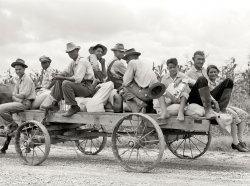
- Motive Power: 1926
- ... train service between New York, Washington, Atlanta and New Orleans."
Alexandria, Virginia, circa 1926. "Southern R.R. Co. ... Posted by Dave - 05/21/2016 - 3:05pm -
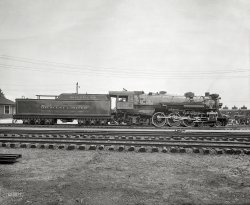
- Special Pleating: 1941
- January 1941. "Old buildings in New Orleans." Custom Buttons and "Sandwiches of All Kind." Photo by Marion Post ... cars debut in 1946.
MAgnolia 2239 Originally New Orleans used geographic telephone exchange names, such as ALgiers, GAlvez, ... as WHitehall and ATwood were introduced. The history of New Orleans telephone prefixes can be found here ... Posted by Dave - 07/15/2014 - 7:49pm -
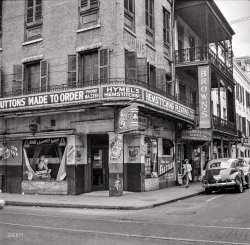
- Difficult Cases: 1941
- January 1941. "Billboards on side of building in New Orleans, Louisiana." Medium format acetate negative by Marion Post Wolcott ... Motors The Mossy family still owns car dealerships in New Orleans.
Mass ≠ Acceleration I went to a church with a similar ... Posted by Dave - 09/19/2019 - 4:13pm -
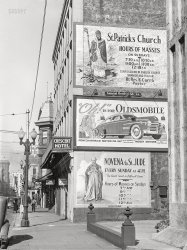
- Royal Street: 1901
- ... and Mobile's Mardi Gras -- is about 150 years older than New Orleans.
In the late 1940s to the mid-'50s, when I was a kid in Mobile, ... Posted by Dave - 08/21/2012 - 5:58pm -
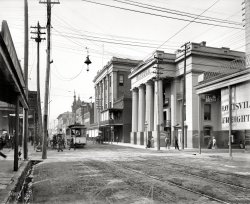
- Young Nicholas: 1906
- Circa 1906. "Oyster luggers at New Orleans." A continuation of the scene shown in the previous post . ... not see or know.
(The Gallery, Boats & Bridges, DPC, New Orleans) ... Posted by Dave - 08/02/2012 - 5:25pm -
![Young Nicholas: 1906 Circa 1906. "Oyster luggers at New Orleans." A continuation of the scene shown in the previous post. Random observation: The masts here remind me of violin bows. 8x10 inch glass negative, Detroit Publishing Company. View full size.
Pommes de MerThose are sweet potatoes. Oystering is only done in the winter and in the summer oyster boats of whatever flavor would haul light freight when they could get the business.
[Now that you mention it, they certainly do look like potatoes. - Dave]
Greetings From Lugger LandingJust a few postcards from the same site.
Tuber luggers?Looks like the boats are carrying some sort of potato-like vegetable.
[Those are oysters. - Dave]
An EpiphanyCould it be our fearless leader has learned the difference between an oyster and a sweet potato?
[This may explain why no one likes my mashed potatoes. - Dave]
Come Aboard!Please walk the plank first.
re: Pommes de MerThis is what is so great about this site. There is always some one who will show you, or teach you something about the subject matter that you did not see or know.
(The Gallery, Boats & Bridges, DPC, New Orleans)](https://www.shorpy.com/files/images/4a07071a.thumbnail.jpg)
- Terminal Station: 1910
- New Orleans circa 1910. "Terminal Station, Canal Street." Demolished in 1956. ... certainly coincide with the time frame.
According to New Orleans - A History of Three Great Public Utilities
Paper read by
Hon. Martin Behrman
Mayor of New Orleans, La.
before Convention of League of American Municipalities, ... Posted by Dave - 03/06/2019 - 11:18pm -
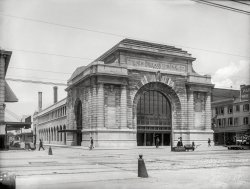
- Inner Sanctum: 1937
- New Orleans, 1937. "Courtyard entrance, 1133-1135 Chartres St." Seen here ... photos at their website.
(The Gallery, F.B. Johnston, New Orleans) ... Posted by Dave - 06/29/2013 - 12:54pm -
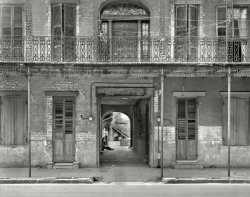
- Night Rider: 1943
- ... (vicinity). "James Hall, truck driver, en route to New Orleans on U.S. Highway 90." Header placard: "Accidents Help the Axis." ... Posted by Dave - 02/02/2017 - 12:40pm -
![Night Rider: 1943 March 1943. Pearlington, Mississippi (vicinity). "James Hall, truck driver, en route to New Orleans on U.S. Highway 90." Header placard: "Accidents Help the Axis." Photo by John Vachon for the Office of War Information. View full size.
They Pose by NightHis engine is warm and he has 60 lbs of air but his Mack's speedometer is at zero and it looks like he doesn't have any oil pressure and the battery is slightly discharging.
[Not to mention the door is wide open. -Dave]
That windshield wiper motor looks a lot like the pneumatically-operated "Air Push" devices found on locomotives.
A slow wipeIs that cylindrical thing above the windshield a vacuum-power windshield wiper actuator?
I hated the way the old vacuum wipers would slow or even stop when you opened the throttle wide. This would of course happen when you were accelerating to pass another vehicle, the exact moment when you need clear vision !
Another comment is that in those days, there were no seatbelts. That wiper motor could be a real problem if his head smacked into it in an accident!
He Drives by NightLike the previous entry by Mr. Vachon, this photo has a very noir-ish atmosphere to it. Both photos chronicling the work of wartime truck drivers remind me of films like "They Drive by Night" and "Thieves' Highway". The FSA-OWI photographers really knew how to use shadow to great effect in their pictures.
"Let us Marfak your car"So says the sticker partly visible on the left side of the dashboard. Once commonly displayed on Texaco service stations, it's seldom seen these days.
http://www.brandlandusa.com/2010/01/23/marfak-lubrication/
Fast WipeWhen I was a little guy my dad had a '39 Chevy with vacuum wipers. Once, when descending a 9,000 mountain road in a very heavy rain he closed the throttle completely and the wipers ran so fast the blade came off. He cursed all the way down.
Live WireThat spotlight must have gotten a lot of use for it to need repair with electrical tape. The tape looks like the old kind made of sticky black fabric (not the plastic kind used today). Spotlights were more common back in those days--even on cars. My Dad had one on the Nash Ambassador that he bought shortly after the end of WWII.
Friction TapeThe proper name of the old-style sticky black fabric tape is "friction tape". It is still available. (Ref: 3M 1755)
It's used as a protective overwrap to protect wire from sharp edges.
Spotlight tapeThis is a terrific photo of things seldom seen anymore. But, the spotlight's taped wires may only be where the pigtail from the manufacturer joined with wires brought up from the ignition switch or other source of power. I still have a couple of rolls of friction tape and use the stuff now and then where some heat is involved. Not as good as it gets, but serviceable.
The Fabric of our LifeThe cloth tape was known as Friction Tape, and was used on everything from electrical repairs to wrapping baseball bats.
Not so long ago Back in the mid-70's I used to work on and drive a late-30's White. It was not very far removed from the truck in this picture. Except it didn't have pneumatics, but instead it was fully vacuum. You haven't lived driving a truck until you have driven with Vacuum/Mechanical brakes! The last daily driver I had with Vacuum wipers was a 1972 AMC Matador. Today my wife's 1962 Mercury Comet has vacuum wipers, so we occasionally still get the thrill of climbing a hill in the rain!
Pneumatic or vacuum?I think Phare Pleigh is probably right that the wiper is air operated. It looks like the pneumatic king pin release found on many tractors today. Since the truck has air brakes it makes sense to use that system for other things.
Also if the engine is a diesel there would be no vacuum.
On the other hand, most trucks back then were still powered by gas engines. Even the Sherman tanks operating around the world at the time were gas powered. So it could be vacuum.
Thanks to the ReadersI am always blown away by the depth and breadth of Shorpy readers' ( Shorpy-ites?) knowledge of antique vehicles and machinery. Model numbers, obscure manufacturer names, details about the internal mechanics, comparisons to similar models from that time -- you guys know it all!
Thanks for sharing all that info.
(The Gallery, Cars, Trucks, Buses, John Vachon)](https://www.shorpy.com/files/images/SHORPY-8d27714a.thumbnail.jpg)
- In the Driver's Seat: 1915
- ... early 1909 she ran this car to numerous victories at the New Orleans Mardi Gras celebration, at one point even beating the famous Ralph ... five trophys.
Not long after her stunning victories in New Orleans, and despite the fact that Mrs. Cuneo had been a member of theirs ... Posted by Dave - 08/29/2012 - 2:12pm -
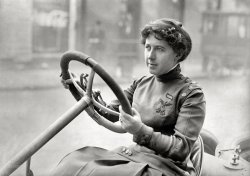
- Railyard Rollers: 1905
- Gulfport, Mississippi, circa 1905. "New Orleans supply yard, Union Naval Stores. Shipment of rosin and turpentine." ... Posted by Dave - 08/08/2012 - 2:50pm -
![Railyard Rollers: 1905 Gulfport, Mississippi, circa 1905. "New Orleans supply yard, Union Naval Stores. Shipment of rosin and turpentine." 8x10 inch glass negative. View full size.
Can't get enough turpentine photos!The gum naval stores industry as practiced before WWII is now mostly forgotten, but was once a Really Big Deal in the longleaf pine belt that stretched from North Carolina to the Gulf coast of Texas. Sadly, most of the longleaf pines are gone now, and several species dependent on the pine forests-- for instance, the ivory-billed woodpecker-- are gone for good.
Those barrels would have been made and filled with turpentine and rosin distilled in small batches at camps located way out in the piney woods, by men working under absolutely medieval conditions. The ones working to pay the company store were lucky compared to the ones who were convicts leased from local law enforcement.
I've seen most of the more widely available turpentining images, but this is a new one on me-- thanks for running it, Dave.
LunchtimeThere appears to be a lovely young lady bringing some lucky gentleman his lunch bucket, and much prestige from his comrades.
Hard labourfor those guys. It looks hot after maybe some recent rain, the barrels sure look heavy and there's a few hours left yet. Looks like there's refreshments being bought over by the youngster on the right.
Thanks for the info Thad, I never knew about turpentine's origin such as shown above.
Even the Lionel Lines1950s model barrel loader was more mechanized than this.
WWWaaa - ter boo-ooyyyBring the buck-buck-bucket here!
I remember that song so well, I could hear it in my mind when I saw this detail.
Never thought abut how rail cars wereloaded by hand before. The sunken rails, two men on a barrel, wooden rails to roll them on, all fascinating!
Safety firstThe bridges over the rail trench are noticeably lacking proper railings. 1 safety demerit!
Good, I'm starved.Here comes lunch!
As far as the eye can seeJust how many hundreds of thousands of barrels of rosin and turpentine could possibly be needed? And for what purpose, painting?
[Used in the manufacture of soap, paper, paint and varnish. More on the "naval stores" industry, and the origin of the term. - Dave]
Turpentine Forests
Washington Post, Sep 15, 1902.
Turpentine Forests.
Their Rapid Destruction Threatens the Ruin of a Great Industry.
From the New York Commercial.
The first organization of turpentine men, known as the Turpentine Operators and Factors' Association, which recently held its first annual convention in Jacksonville, Fla., was confronted by the question of complete annihilation of their business, due to the ruthless tapping of young trees and the rapid depletion of the pine forests. Ten years ago Norfolk, Va., was the great naval stores port of the United States, five years ago Charleston was the center of the industry, two years ago Savannah, and now Jacksonville, and next Tampa and then — what? Prof. Herty, of the United States Department of Forestry, has been called upon and was present at the convention.
Newspapers in the South have presented able articles on this same subject for years, but the writer has seen young trees no thicker in diameter than eight inches boxed; once, twice, yes three times, so that a step ladder was used for the top boxing and the strip of bark left was insufficient to gather the sap to feed the tree. The life of a turpentine tree after the first boxing is about two years. That means that after the sap has been taken the third time the tree must either be cut for timber or it dies. A trip through the pine forests of Georgia and Florida will demonstrate the reckless manner in which the boxing has been done, and, worse still, where clearings have been made, no effort has been made to check the growth of scrub oak and saw palmetto which effectually choke the young pine rearing its head where its parent stood. Gradually the operators have been driven south, and to-day it is estimated that at least one hundred camps are located in Florida alone, and about fifty camps in Georgia.
Nine hundred operators were at the convention. Each man has either bought or covered with options more or less pine forest, and in spite of his knowledge of what the future will bring is rapidly killing the goose with the golden egg. The end is near in the turpentine and rosin industry. A few more years will see a tremendous rise in these commodities, and no effort has yet been made to restore the depleted forests of Virginia, Georgia, Alabama, North Caroline, or Northwestern Florida. The "fat pine" is indigenous to these States, it grows rapidly, but is easily exterminated by the more sturdy plants which spring up in the forest clearings.
(The Gallery, Boats & Bridges, DPC, Railroads)](https://www.shorpy.com/files/images/4a17950a.thumbnail.jpg)
- Just Us Girls: 1940
- ... these tots, on a roll of pictures taken in what looks like New Orleans. 35mm nitrate negative by John Vachon. View full size.
Jazz ... a case of the Owlies.
(The Gallery, John Vachon, Kids, New Orleans) ... Posted by Dave - 11/26/2011 - 1:00pm -

- Traveller: 1903
- March 23, 1903. "High water at the New Orleans, Louisiana, levee, Mississippi River." 8x10 inch dry plate glass ... probably... mules.
(The Gallery, Boats & Bridges, DPC, New Orleans, Railroads) ... Posted by Dave - 10/11/2021 - 11:53am -
